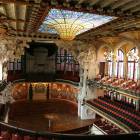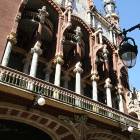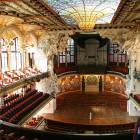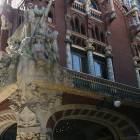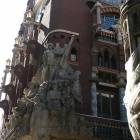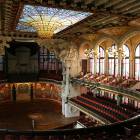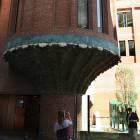The splendid Art Nouveau concert hall in Palau de Musica Catalana, Barcelona
For the large public, Antoni Gaudi is the name associated with Spanish modernism in architecture. But the brilliant builder of Sagrada Familia was part of a larger generation of intellectuals, that marked a Rebirth in Catalonia, in the decades at the end of XIX, beginning of XX century. They were very interested in modern ideas and techniques, but looked to give modernity a humane and local color, seeking to present this part of Spain as distinct and vibrant. Among them, Domenech i Montaner was a truly man of Renaissance: a politician, architect, professor, interested in studying plants and animals.
The Musical Palace is the masterpiece of Domenech i Montaner, but this prolific creator did a lot of other works in Barcelona and throughout Spain. The Hospital of Saint Paul and The Music Palace are included on the World Heritage List, but other important contributions include: Casa Lleo Morera, Casa Fuster (some very Gaudi-like projects), the Grand Hotel in Palma de Majorca, the Mudejar influenced Casa Roura, or renovations to Castle Santa Florentina or Catle of the Three Dragons, in Parc de la Ciutadella, Barcelona.
The passion for elegant curves, instead of straight lines, for amazing decorations and for incorporating natural shapes into buildings remain constant in the Modernist school of Barcelona. The personal note by Domenech i Montaner is given by his incredible interest in plants and animals, which he implements in jaw dropping designs. Such is the case with the forest-like palm leaves that cover one of the exterior columns of the building. And is also present in the main concert hall, where sound takes a sculpted shape. The muses from Greek mythology emerge from painted ceramic walls, the Valkyries of Richard Wagner explode from the side walls, to embrace folkloric motifs from Catalan songs, covering classical capitals and Beethoven’s bust. Even when empty, this concert hall seems to have a stone chorus shouting.
Another particularity of Domenech i Montaner’s style was his combination of simple and complicated. For structure, he went for the newest methods available, using curtain walls, light structures that were less expensive and easier to use, allowing for larger open spaces. But on top of those invisible structural elements, he put the most elaborate decorations. No traditional or modern craft was spared. From ceramic plates to iron work, apparent brick walls, bass-reliefs and sculpture.
The most beautiful decorative and functional object is the glass ceiling by Antoni Rigalt, with it’s amazing inverted dome, that symbolizes a yellow sun against a blue background. In fact, the whole concert hall is covered in stained glass windows that make it possible for concerts to take place with natural light during the day. The large organ above the scene is another element borrowed from the interior of cathedrals.
The concert hall is especially designed for music concerts. The lower front seats can be retracted to extend the scene, while the balconies offer if not the best visibility, at least excellent acoustics. The greatest names in music have sang here, usually opera music, but it was also used for pop experimental concerts. Composers like Maurice Ravel, Richard Strauss, Sergei Prokofiev, Igor Stravinsky, Sergei Rachmaninov, or George Enescu presented their works here. Philharmonic orchestras conducted by: Herbert von Karajan, Zubin Mehta, Leonard Bernstein and Sergiu Celibidache played here.
The commissioner was the Choral Society of Barcelona (Orfeo Catala), an amateur society for music lovers, that also gathered the necessary funds. The project was ready in a very short time, in just three years, between 1905 and 1908.
Mai multe despre: Architecture, Spain • Antoni Rigalt • Architecture • Art Nouveau • Barcelona • Catalunia • decorative arts • Lluis Domenech i Montaner • modern architecture • Music Palace • Palau de Musica Catalana • Spain • stained glass- Home Page
start page - Architecture
landmark buildings - Sacred architecture
places of worship - Nature
landscape photography - Concert
performing artists - Christmas
Santa Claus pictures
- Jooble
jobs for photographers - Escape
an out of control blog - Merry Christmas
The best organizer of Christmas parties - Astro photo
Eclipse hunting and astrological photography

